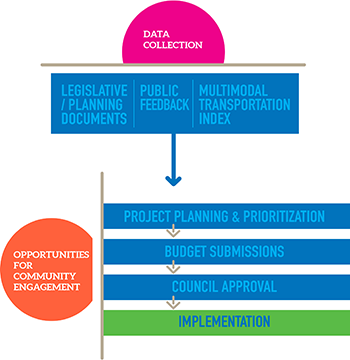Moving Red Deer Forward
Moving Red Deer Forward: Our Multimodal Transportation Plan
What is Moving Red Deer Forward?
Multimodal Transportation Plan - Moving Red Deer Forward (pdf) is our new multimodal transportation plan, which puts all of The City’s past work on multimodal transportation into action and is the foundation for how we will improve our transportation network today, tomorrow and in the future. Enabling us to plan, prioritize and evaluate transportation projects, the multimodal transportation plan aims to improve the safety, quality, comfort, connection of all modes and provide more choice for residents.
How was Moving Red Deer Forward developed?
The vision for multimodal transportation was first set in the Mobility Playbook (pdf) , which was adopted by The City, with significant community engagement, in 2013. A commitment to multimodal transportation is also reflected in our Municipal Development Plan and through Council mandate statements for each mode:
Drivers in Red Deer will drive on quality roads. Trips will be efficient and unimpeded by frequent stops, blind spots, and other mode users. The driving experience will be safe and convenient.
Pedestrians in Red Deer will have high quality footpaths that are well maintained, continuous, and connected to all destinations; pathways will be designed for safety and comfort, and accessible to all ages and abilities.
Cyclists in Red Deer will be able to move through the city on separated or designated pathways that are free of barriers, well lit, clear of snow and debris, and connected to key destinations and amenities. Pathways will be safe, comfortable, enjoyable and understood by Red Deerians.
Transit riders will have access to a frequent, connected and friendly transit service. Transit stops will provide a comfortable and safe waiting experience protected from the elements and provide current information that is easily attainable by riders.
Moving Red Deer Forward builds on all of this past work, and translates the vision and mandate statements into outcomes and projects for each mode, including motor vehicles, walking, cycling, transit and future rail.
Outcomes
The goal of the multimodal transportation plan is to provide Red Deerians with a balanced transportation network that provides choice for residents; it’s not about making all modes equal on all routes. The plan highlights priority routes for each mode and considers how these routes can work together to create a more connected network, taking advantage of existing infrastructure when possible.
Moving Red Deer Forward envisions the following outcomes:
A motor vehicle network that:
- Encourages safe travel on roads designed for the posted speed limit
- Anticipates future capacity needs and considers all modes
- Is well maintained year round
An active transportation network for pedestrians and cyclists that is:
- Free from gaps
- Provides direct routes to key destinations
- Makes the best use of existing infrastructure (e.g., multi-use trail system)
- Connected to transit stops
- Well maintained year round
- Accessible for all ages and abilities
- Well signed and easy to navigate
- Designed for safety of all users
- Connected to regional trails
A transit network that has:
- Direct routes
- Connections to the pedestrian and cycling networks
- Frequent service
- Safe, comfortable and accessible shelters
- Easy to read timetable information
- Connections to regional transit
A future rail network that:
- Recognizes Red Deer as a central hub of the province
- Connects to other modes of public transportation
- Makes the most of the land use opportunities in Red Deer
How will the plan be used?
This diagram highlights how we will use the multimodal transportation plan to plan, prioritize and evaluate transportation projects in a coordinated way and bring them forward for approval and public consultation through our budget process.
 One of the key benefits of the plan is that it is data driven, and we have many sources to draw on including:
One of the key benefits of the plan is that it is data driven, and we have many sources to draw on including:
- Legislative and planning documents (Municipal Development Plan, Strategic Plan, Environmental Master Plan, etc.)
- Feedback received from the public about traffic, safety concerns, specific routes/modes, etc.
- The Multimodal Transportation Index (MTI), a tool we’ve developed to measure and evaluate the walking, cycling and transit experience based on specific criteria including, safety, connection, quality, comfort, and cost. Much like the tool we use to measure and evaluate pavement quality when identifying areas for improvement in our road network, the MTI will be used to evaluate and identify gaps in our trails, sidewalk, cycling and transit network.
This data will then help Administration plan and prioritize multimodal transportation projects as we prepare our annual capital budget submission. Next, Council will review these budget submissions and, if approved, projects will be implemented. Throughout this process, there will be opportunities for community engagement to ensure the needs of the community are reflected in the decisions.
What does it mean for citizens?
The implementation of the plan means citizens will have choice when it comes to how they move in Red Deer; however, it’s a long-term plan and change will be incremental. In the long-term, we’ll be working towards the outcomes, but in the short-term, citizens will start to see changes, such as: identifying and filling in gaps in sidewalk and trails, improving pedestrian safety through installing Rapid Rectangular Flashing Beacons and countdown timers, maintaining trails during winter and improving transit shelters.
What’s next?
With Moving Red Deer Forward in place, multimodal transportation projects will be identified and considered yearly through the budget process. But more than that, multimodal transportation will be embedded into broader planning at The City. And, as new projects are proposed, citizens will be engaged in the process to help ensure the needs of all users are met.